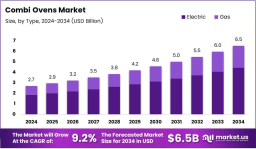

In the ever-evolving culinary landscape, the convergence of efficiency, precision, and multifunctionality has culminated in the rise of combi ovens. These hybrid marvels of culinary engineering fuse convection, steam, and a combination mode enabling chefs to bake, roast, steam, and reheat within a single unit. Originating in European professional kitchens during the mid-20th century, combi ovens have transitioned from luxury equipment to essential appliances across commercial and institutional kitchens.
For more info please visit: http://market.us/report/global-combi-ovens-market/
Several powerful forces are propelling the global combi ovens market forward. Rising demand for automation in foodservice operations is central. These ovens reduce human intervention, minimize errors, and accelerate cooking cycles—making them ideal for high-volume commercial kitchens. Additionally, the surging popularity of cloud kitchens and QSRs (Quick Service Restaurants) underscores the appetite for smart, programmable cooking systems.
Energy efficiency and sustainability imperatives are further catalyzing adoption. With energy costs escalating and environmental regulations tightening, combi ovens’ precise energy use and reduced food wastage align with green kitchen mandates.
Despite robust momentum, the market is not without friction. High initial capital expenditure continues to deter small-scale operators. Moreover, the need for skilled operators capable of navigating programmable settings and maintenance protocols limits deployment in certain regions. Technical glitches, particularly with sensor-based controls, can disrupt operations, impacting reliability perceptions.
Boiler-based combi ovens dominate large-scale operations where steam intensity and volume are critical. These units generate steam rapidly and consistently, making them favorites in institutions and hotels. However, they require more maintenance and water treatment systems.
Boilerless variants, meanwhile, inject water directly onto heating elements to create steam. They are compact, energy-efficient, and require less maintenance ideally suited for cafes, bistros, and food trucks. The shift toward these units reflects a broader trend of decentralizing food production and adapting to limited-space kitchens.
Commercial users spanning restaurants, bakeries, and caterers constitute the lion’s share of demand. Institutions such as hospitals, schools, and correctional facilities also rely heavily on combi ovens for bulk meal preparation with dietary precision.
Residential adoption, while nascent, is gradually increasing. Affluent households and culinary enthusiasts are embracing compact combi ovens for their versatility and gourmet capabilities. Smart home integration and countertop models are helping this segment gain traction.
Europe leads the charge, particularly Germany, France, and the UK fueled by strong culinary traditions, regulatory push for energy-efficient appliances, and established manufacturers. North America, with its vast network of commercial kitchens and rising trend of healthy eating, follows closely.
Asia Pacific is the rising star. Nations like China, India, and South Korea are witnessing explosive growth in hospitality and foodservice sectors. Government incentives for energy-efficient appliances, coupled with urbanization and growing food delivery ecosystems, are bolstering adoption.
Safety certifications, hygiene standards, and energy compliance norms shape market entry and product design across regions. For instance, Europe’s Ecodesign Directive and the U.S. Department of Energy’s appliance efficiency standards heavily influence innovation pathways. Meanwhile, import tariffs and regional manufacturing disparities affect pricing and distribution, creating both hurdles and opportunities for global players.
Innovation in the combi oven space is fervent. Features like humidity control sensors, programmable memory settings, self-cleaning systems, and IoT integration are now commonplace. Smart combi ovens, equipped with data analytics and remote monitoring, are redefining operational transparency and culinary precision.
Eco-design is gaining prominence. Water-saving mechanisms, recyclable materials, and carbon footprint calculators embedded within the oven interface are enabling businesses to align with sustainability goals.
Global giants like Rational AG, Electrolux, Alto-Shaam, and Henny Penny are dominating market share through continuous R&D and global expansion. Strategic partnerships with culinary institutions, service providers, and cloud kitchen aggregators are fortifying their market positions.
M&A activities are reshaping the landscape. Smaller innovators are being absorbed by legacy brands, ensuring rapid integration of niche technologies into mainstream product lines.
For more info please visit: http://market.us/report/global-combi-ovens-market/
The combi ovens market is poised for resilient expansion, with a CAGR projected in the mid to high single digits over the next decade. Demand will be buoyed by expanding foodservice infrastructure, digital transformation in kitchens, and rising consumer demand for healthier, fresher meals.
Emerging economies are expected to witness above-average growth, driven by infrastructure development and foreign investment in hospitality sectors.
Southeast Asia, the Middle East, and parts of Africa represent fertile ground for investment. As culinary cultures globalize and tourism booms in these regions, there’s a rising appetite for reliable, efficient cooking systems. Moreover, educational institutions and healthcare facilities in these areas present long-term deployment opportunities.
Additionally, the residential segment remains underexplored. Compact, affordable combi ovens tailored for urban homes could unlock a massive consumer base, particularly in space-constrained metropolitan areas.
Conclusion
The global combi ovens market is in the midst of a transformative phase. As kitchens across the world pivot toward efficiency, sustainability, and smart automation, combi ovens stand at the forefront of this evolution. The road ahead promises innovation, expansion, and significant commercial opportunities for stakeholders who can blend performance with adaptability.
| No comments yet. Be the first. |